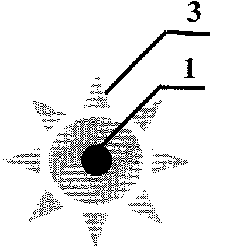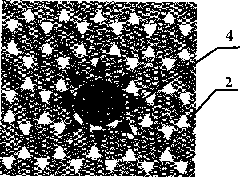Metal micro-nano structure for improving Raman scattering of molecule
A micro-nano structure and Raman scattering technology, applied in the micro-nano field, can solve the problems of low enhancement factor and expensive equipment
- Summary
- Abstract
- Description
- Claims
- Application Information
AI Technical Summary
Problems solved by technology
Method used
Image
Examples
Embodiment 1
[0042] This embodiment is to strengthen the metal micro-nano structure of glucose solution.
[0043] The realization process is as follows: (1) According to the small molecular structure of the detection molecule glucose, discrete dipole approximation (DDA) is selected as the electromagnetic field calculation method, and the calculation capacity of the workstation is about 8G;
[0044](2) The input division grid is 1024×1024 matrix, the surrounding medium environment condition is air, the refractive index is 1, and the excitation light is 442nm laser; the metal gold is selected, the characteristic size is 50nm, the period is 300nm, and the regular hexagonal arrangement Triangular array with a thickness of 20nm;
[0045] (3) Using computational simulation methods to simulate the extinction characteristics Qext, absorption characteristics Qabs and scattering characteristics Qsca of metal micro-nano structures; absorption characteristics Q abs =C abs / πa 2 eff , where C abs ...
Embodiment 2
[0052] This embodiment is a metal micro-nano structure that reinforces solid molecules. (1) According to the fact that the molecular structure and wavelength of the probe are basically equivalent, the FDTD electromagnetic field calculation method is selected, and the calculation capacity is about 2G; (2) The input grid is 512×512 matrix, the excitation light is 365nm laser, and metal silver is selected, and the characteristic size is 150nm, a period of 350nm, a diamond-shaped array arranged in a quadrilateral, and a thickness of 120m; (3) Use computational simulation methods to simulate the extinction characteristics Qext, absorption characteristics Qabs and scattering characteristics Qsca of metal micro-nano structures; (4) Calculate and simulate metal micro-nano structures The plasmon resonance frequency of the structure is 360nm, and compared with the system excitation light frequency of 365nm, the two are basically equal, and directly transferred to the next step; (5) Calcu...
Embodiment 3
[0055] This embodiment designs a metal micro-nano structure that strengthens TNT gas molecules. (1) According to the detection of the small molecular structure of TNT, discrete dipole approximation (DDA) is selected as the electromagnetic field calculation method, and the calculation capacity is about 4G; (2) The input calculation grid is divided into a 980×980 matrix, and the surrounding medium is a vacuum with a magnetic field, The excitation light is 780nm, metallic silver is selected, and the characteristic size is 30nm. A triangular array with a period of 250nm and a quadrilateral arrangement, with a thickness of 50nm; (3) use computational simulation methods to simulate the extinction characteristics Qext, absorption characteristics Qabs and scattering characteristics Qsca of metal micro-nano structures; (4) calculate and simulate the metal micro-nano structures Plasma resonance frequency λ LSPR , and compared with the system excitation light frequency λex, the two are ...
PUM
 Login to View More
Login to View More Abstract
Description
Claims
Application Information
 Login to View More
Login to View More - R&D
- Intellectual Property
- Life Sciences
- Materials
- Tech Scout
- Unparalleled Data Quality
- Higher Quality Content
- 60% Fewer Hallucinations
Browse by: Latest US Patents, China's latest patents, Technical Efficacy Thesaurus, Application Domain, Technology Topic, Popular Technical Reports.
© 2025 PatSnap. All rights reserved.Legal|Privacy policy|Modern Slavery Act Transparency Statement|Sitemap|About US| Contact US: help@patsnap.com



